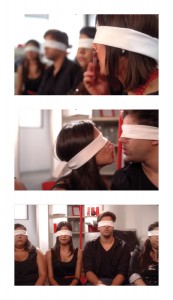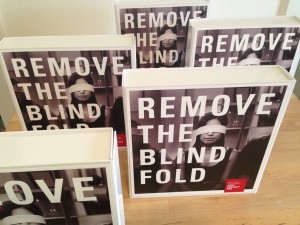Art Center Alumna Elizabeth Bayne Develops HIV PSA Campaign for Local Non-profit
Elizabeth Bayne, a 2011 Honors Fellow and Art Center College of Design graduate, holds an MFA in Broadcast Cinema. In 2009, she was part of Designmatters’ first Safe Agua delegation to Latin America and the first film student to develop a documentary short on behalf of the program, initiating what is now a thriving relationship between both departments. Before Art Center, Ms. Bayne studied at the Yale University School of Public Health, followed by a research fellowship at the U.S. Environmental Protection Agency in Washington, D.C. Both experiences convinced her of the influence media have on public health, behavior and well-being and the importance of using media to create change. Ms. Bayne currently works as a video producer at the top ranked USC Viterbi School of Engineering developing online content about their students, faculty and innovative research in science and technology.
When Women In Film, Los Angeles approached me to direct a public service announcement (PSA) through their PSA Production Program, I was in the middle of my final term at Art Center. Although this was a very busy time as most alumni know, it was an offer that I couldn’t refuse. I’d been waiting for the opportunity to direct a television PSA through the program for three years ever since I’d started attending their weekly meetings as a first term student in 2009.
Women In Film, Los Angeles (WIF) is a non-profit organization dedicated to helping women gain experience and find opportunities in film and entertainment. Their award-winning PSA Production Program produces three to four public service announcements a year for local charities throughout Los Angeles. I was paired with Whittier Rio Hondo AIDS Project (WRHAP), a local charity that provides HIV testing and counseling services for underserved communities, including outreach to shelters and drug treatment centers. The charity asked us to produce the PSA to promote HIV testing among women in the Latino community.
CHALLENGES TO A LOCAL PSA
While creating a PSA through WIF is a great opportunity, there are challenges to creating an effective PSA campaign in today’s media saturated environment. First, most non-profit organizations lack the same financial resources as large corporations to produce the slick advertising campaigns we see on television. Our PSA was to be shot on 35mm film, an expensive medium, especially considering that WIF’s grant funding had experienced cuts the year before due to the recession. The second challenge was desensitization. Since its discovery and initial controversy in 1982, people have become desensitized to HIV/AIDS messaging while the stigma and fear of being tested remains. Finally, just because a PSA is made doesn’t guarantee that it will receive air time. Production is only half the battle. PSAs rely on donated space and air time, competing for station managers’ attention to gain the precious few time slots available for unpaid advertising.
ENGAGING THE COMMUNITY
Solutions to these challenges came from the production team and WRHAP staff. Everyone involved in planning and producing the PSA volunteered their services. [You can read about our creative team here.] My producing team of Clora Ferguson, Shay Moore and Ande Richards, the WRHAP staff and I cold-called dozens of places and received tax-deductible in-kind donations and generous discounts from vendors, such as Kodak, Deluxe, Company Three and TV Access. We received direct donations through crowd sourcing on Indiegogo, as well as from local grocery stores to feed our team of volunteers on the day of production. I was amazed and humbled to witness how people stepped forward to help and support WRHAP’s cause.
REBOOTING THE HIV MESSAGE
The second solution was to find a unique and targeted message that audiences hadn’t heard before regarding HIV/AIDS. After receiving the charity’s creative brief, we met with WRHAP staffers Sherry Aguilar and Leslie Marlephansakul to learn more about the organization and their goals. One statistic that really floored us was that, ” Eighty percent (80%) of women diagnosed with HIV are in a relationship.” No one in that initial meeting had heard that before, and we were sure not many women were aware of this. This fact became the focus of the PSA with the primary message that even women in relationships should get tested. Our goal is to remind women to keep track of their status, especially when entering new relationships.
BREAKING THROUGH THE CLUTTER
This focus also became the solution to our most difficult challenge, how to make our message stand out and “break through the clutter” of media advertising. We conducted informal focus groups with WRHAP’s clients to learn more about the target audience. Their personal stories were incredible, and we were honored to have them share with us. We collected information about their backgrounds, interests, fears, and hopes and did our best to create a message that would resonate.
SPEAKING IN METAPHOR
We took our creative lead to use visual metaphor from iconic and memorable PSAs, such as the egg frying in a pan for the Partnership for a Drug-Free America’s “This is your brain on drugs” campaign and the gold fish gasping for air while a child’s voice describes having an asthma attack as feeling “like a fish out of water” for the U.S. Environmental Protection Agency’s Childhood Asthma campaign. Montana Mann, an Art Center film student, and I wrote the spot, which centers around a group of blindfolded people at a party playing a kissing game that involves passing a playing card around in a circle. The scene serves as a visual metaphor for multiple sexual encounters and the risk of not knowing your status. It’s confrontational, ending with a woman staring directly into camera to challenge viewers to take the call to action and get tested. I worked with my director of photography, Sandra Valde, and production designer, Lawrence Kim, to develop a signature look involving red, black and white. [You can read about the symbolism here.] Art Center alumnae, Nubia Mercado and Stella Hernandez provided the Spanish translations.
BRANDING THE CAMPAIGN
After wrapping production, we decided not to stop at the PSA alone. Even if the spot itself was strong, we still needed station managers, the final gate keepers to our audience, to reach in their bin of PSAs and remove our tape from the box. I went back to my training at Art Center about professionalism, presentation and branding. Most tapes that stations receive come in dull gray cases with a single label. We took it to the next level, recruiting graphic designer Angie Stalker to develop a brand identity for the campaign, packaging for the tapes and postcard reminders to send to stations before certain HIV/AIDS awareness days throughout the year.
The campaign launched online this year on March 10th for National Women and Girls HIV/AIDS Awareness Day. We now have the encoded tapes, so we can track how often the spots air on local stations, and will distribute them by April. It’s very exciting to work on a project with a real world application using the skills I learned at Art Center.
Developing a PSA campaign has been a challenging, but very rewarding experience. When I open our box and hold the tape in my hand, it’s amazing to think of all the people who contributed their time and resources over the last year to support the campaign. As soon as you tell people what you’re doing and who you’re doing it for, they want to help. WRHAP does amazing work for the community and it was humbling to see so many people step forward to support them. We hope the PSA reaches a lot of women, not just our target audience of Latinas, and motivates them to get tested for HIV.
For more information about WRHAP or for testing services, visit: wrhap.org



